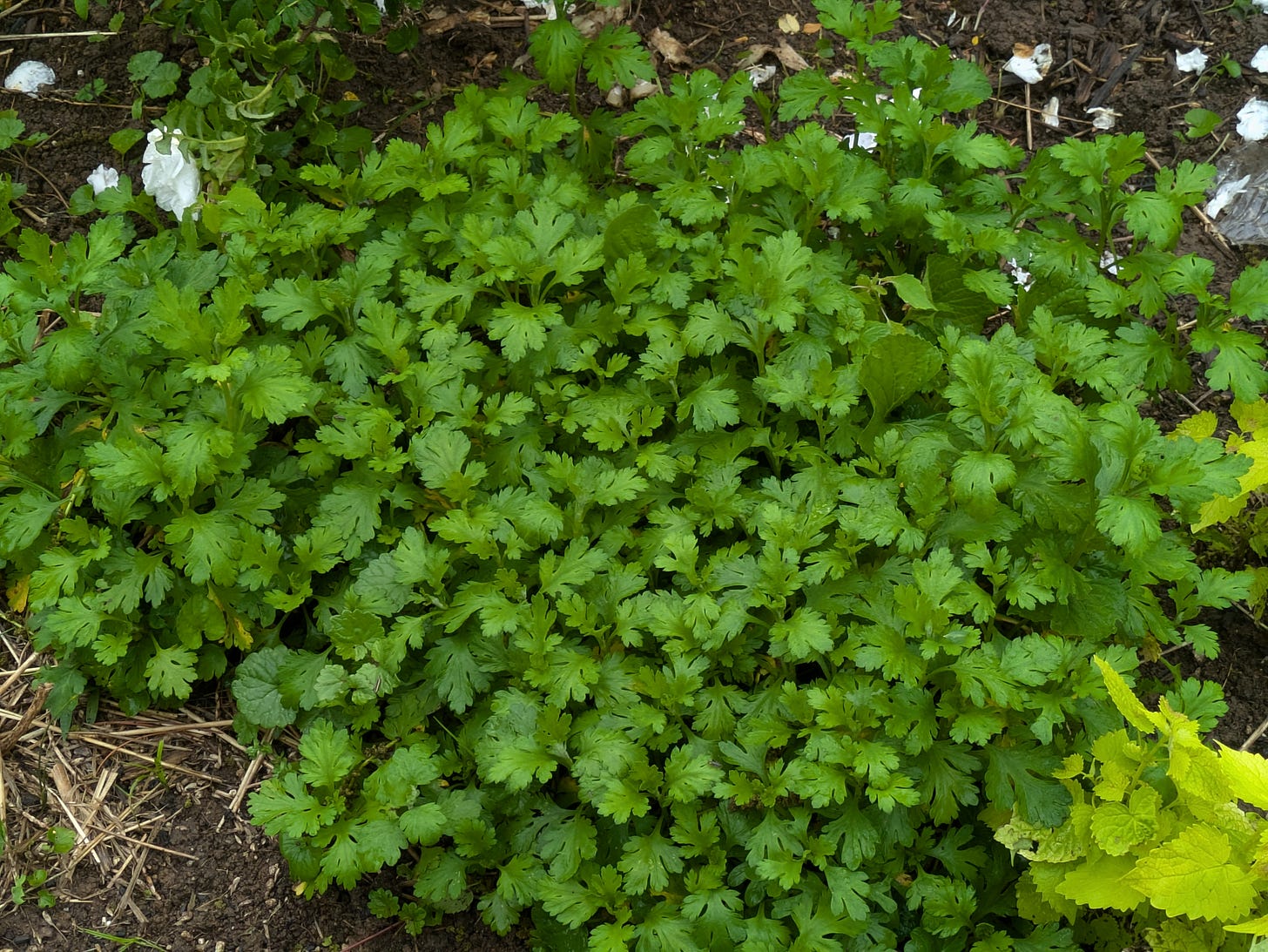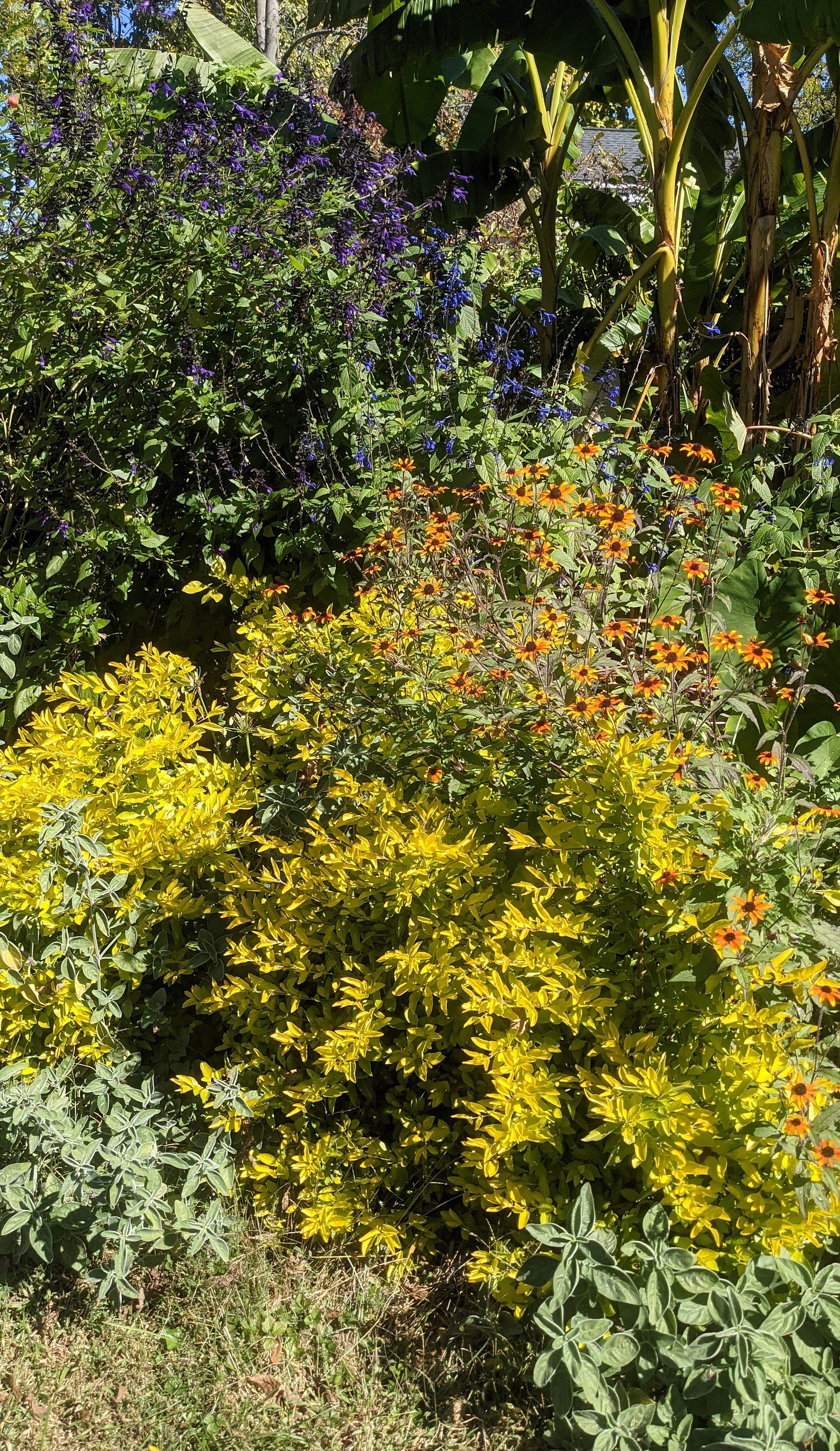What I’ve come to refer to as the annex bed was constructed several years ago by dint of sweaty labor and my occasionally balky Mantis rototiller, resulting in a smoothly countoured island bed measuring roughly 35 feet long by 15 feet at its widest point. Owing to damp and sometimes chilly spring weather (and to be honest, a degree of hard work avoidance), getting the bed into shape was delayed. This past week I completed edging and weeding on the plot, which is beginning to display its potential for 2025.
Last year’s emphasis was on spring expansion/makeover for fall display, chiefly using asters such as ‘October Skies’ and ‘Wood’s Purple’ and chrysanthemums, which in my experience need planting early in the growing season if they’re going to have a reasonable expectation of surviving the winter. Even with the mums marketed as “hardy perennials”, if transplanted after midsummer the odds of their overwintering start to decline, the more so if they’re purchased as potted flowering plants that lack new basal vegetative growth.

Flowering this time of year is largely the province of rugosa roses, the white ‘Blanc Double de Couvert’ and a red, ‘Moje Hammarberg’. In addition, ‘Sunny Knockout’ has come back well and begun blooming.
Say what you will about overplanting of Knockout roses, particularly the red-flowered forms, they’re dependable, relatively low maintenance shrub roses. ‘Sunny Knockout’ has the added bonus of light to moderate fragrance, which is next to impossible to find in modern low care landscape roses, not to mention having been largely bred out of other perennials once known for fragrance.
The Jellito seed-grown Salvia pratensis hybrid ‘Twilight Serenade’ has been flowering for several weeks, and will hopefully rebloom from vigorous basal growth once the first flowering stems have been cut back. Several S. nemorosa hybrids are coming into bud, including ‘Blue Queen’, which has begun blooming in the main border:
Two plants of Salvia ‘Big Blue’ surprisingly have come back for a second season in the annex bed, and together with cutting-grown plants that were overwintered indoors will get another chance in 2025 to strut their stuff. I wasn’t enormously impressed with ‘Big Blue’ last year as it didn’t quite match the performance of the related S. ‘Indigo Spires’, but in a sunnier location may show improvement.
Another Salvia, this one a hybrid of S. guaranitica is new to us in 2025. 'Van Remsen' is touted as a tall (seven foot!) sage with cobalt blue flowers and lacking running tendencies which may be problematic in warmer climates though I haven’t experienced such a problem in the “zombie zones” (z. 6 and 7). I took a number of cuttings of the stock plant indoors this past winter, so there are now several plants to try in various locations to supplement other S. guaranitica hybrids, ‘Black and Blue’, ‘Black and Bloom’ and ‘Purple and Bloom’, all of which have been dependably hardy returning perennials here. Lastly (among annex bed Salvias) I’m welcoming back S. ‘Silke’s Dream’, an orange-red-flowered cross between S. darcyi and S. microphylla which is said to tolerate zone 7 winters.
Tree morning glories (Ipomoea carnea) are intriguing plants that, unlike their cousin, the commonly grown morning glory (Ipomoea purpurea), do not have a vining habit but instead are shrub-like with woody stems six feet or more in height, flowering in pink and white. They’re only hardy to zone 9, but when started from seed in early spring will flower the same season, given ample sun. I grew I. carnea when I lived in SE Texas and again in my Ohio garden. A fond memory is of seeing small green tree frogs perched high in the stems of tree morning glories, hoping to dine on tiny insects that are drawn to the flowers. Ipomoea carnea can also be propagated by semi-hardwood cuttings in fall and overwintered indoors. I have a single clump of the pink-flowered strain planted in the annex bed which will eventually tower over neighboring crepe myrtles.
For a couple of years now I’ve been growing another shrubby plant, Erythrina herbacea, also known as coral bean, whose native range in the U.S. covers a large portion of the southeast, particularly Gulf coastal states. It’s a large shrubby plant with thorns, whose main attraction is long tubular scarlet flowers that appear early in the growing season. While it’s hardy as far north as parts of USDA zone 6, it’s killed to the ground in the northernmost parts of its range, making a reappearance in mid-spring. I’ve yet to see flowers, possibly because it tends to flower on the previous season’s wood before leaves appear. No surviving wood = no flowers? Anticipating that this will be the case, I plan to yank E. herbacea if no bloom occurs in 2025, substituting Erythrina x bidwillii, a hybrid between E. herbacea and E. crista-galli which is claimed to produce similar tubular red flowers on new growth between June and frost, while eventually growing into a sizable shrub. It’s rated hardy to at least zone 7b, which puts it on the fringe of my growing area but worth a try given good drainage and winter mulching.
Since exotic plantings must have bananas, the annex bed will once again feature Musa itinerans ‘Mekong Giant’ (the Royal Horticultural Society insists on calling it Musa itinerans var. xishuangbannaensis ‘MeKong Giant’, which seems a bit much). In the few years I’ve been growing it, both in the main border and annex bed, it’s proven as reliably hardy as the more frequently grown Musa basjoo. ‘Mekong Giant’ emerges about 10 days to 2 weeks later in spring than M. basjoo, but eventually its growth catches up to and can exceed basjoo, topping out at 9-10 feet tall here most years, depending on adequacy of summer rainfall. One difference that bears watching is that ‘Mekong Giant’ is a running banana, submarining underground stems so that new shoots pop up a foot or more from the original trunks. These can be dug out and replanted or just cut off to keep the planting in bounds.

Several varieties of new Agapanthus have been added to complement existing plantings of ‘Galaxy Blue’ and ‘Hardy Blue’. ‘Headbourne Hybrids’ are a venerable strain developed in the U.K., flowering in shades of blue and rated hardy to zones 6-7 depending on what sources you trust. Five vigorous young plants grown from seed sown last fall may not flower this year, but are a decent bet to do so in 2026. ‘Navy Blue’ is a cultivar popular in British gardens. Currently showing its first bud is a departure from traditional Agapanthus, ’‘Twister’, which features white flowers transforming to blue-purple at their bases. Both ‘Navy Blue’ and ‘Twister’ should be hardy here in zone 7a, but will be well-mulched at least for their first winter in-ground. Multiple cultivars of Agapanthus have been relatively maintenance and pest-free, given sun, adequate drainage and protective winter mulch. They can be trimmed once foliage is killed to the ground by late fall frosts, or that job can be postponed until spring. Agapanthus foliage can be evergreen in warmer climates.
Blues fans are further rejoicing in anticipation of bloom from newly added perennials Anchusa azurea ‘Feltham Pride’ also known as Italian alkanet or bugloss, and Eryngium ‘Blaukappe’ a.k.a. sea holly, both grown from seed sown in summer 2024 with potted plants overwintered in a frost-free location before transplanting into the annex bed earlier this spring.
Following their first winter in the ground, we’re five for five on survival of flame acanthus, Anisacanthus quadrifidus v. wrightii. Both I and the hummingbirds are hoping for abundant flowering in 2025, the plants’ second full season.
The northern end of the annex bed is home to a couple varieties of canna, one of which overwintered and evidently has multiplied from 2024. If only I could remember what variety it is…we’ll find out in a month or so. The other canna comprises a dozen plants of a compact sort, grown from seed of ‘South Pacific Scarlet’. I grew this one for a number of years in Ohio, dutifully digging up and storing tubers in a cool location each winter and eventually transporting them to Kentucky, where my experiment in overwintering them in the ground did not succeed. I had saved ample seed, which I was pleased to see survived 5+ years of storage and achieved excellent germination when started late this past winter. The best way I’ve found to handle canna seeds is to use scissors to scrape off a bit of outer seed coat, then soak the seeds in warm water for a couple days before sowing in a soilless mix. ‘South Pacific Scarlet’ grows to about 4 feet in height; its seed progeny might be more variable.
A foliage combination I’ve enjoyed for a couple of years will get another opportunity in ‘25. Duranta repens ‘aurea’ is a low-growing, non-flowering plant with yellow foliage that pairs well with Persian shield (Strobilanthes dyerianus), which displays purple and pink leaves having an almost metallic sheen.

On the large and lusty side, Alocasia ‘Sumo’ will get a prime spot in the near future, once it’s fully hardened off to sun, wind and cooler nighttime temps. ‘Sumo’ is a potential 8-10 foot giant with green leaves topside and bronzed coloration underneath, plus reddish leaf ribs. Given ample sun, moisture and feeding, it should provide another of those subtle touches so appreciated by horticultural cognoscenti. Come fall it’ll need to be cut back and potted for overwintering indoors.
Plants whose 2025 roles are still in doubt are a butterfly bush (Buddleia ‘Black Knight’) which evidently had a hard winter and has shown few new shoots to date, a red-flowered phlox which is struggling a bit and several desert birds of paradise, Caesalpinia gillesii, which have overwintered and flowered here the past two years, but don’t typically emerge until nearly the end of May. If these players don’t perform as expected, the good news is that call-ups from the minor plant leagues and strategic acquisitions are available to fill any gaps.
Updates to follow.









